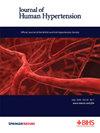Relationship between epicardial adipose tissue thickness and sedentary time, physical activity level, and physical performance in patients with hypertension
IF 3.4
4区 医学
Q2 PERIPHERAL VASCULAR DISEASE
引用次数: 0
Abstract
Epicardial adipose tissue is associated with the development of cardiovascular disease and its increase is positively correlated with blood pressure elevation in hypertensive individuals. In the literature, being physically active has been shown to be effective in the treatment of hypertension and reduction of epicardial adipose tissue thickness. The aim of this study was to evaluate the relationship between epicardial adipose tissue thickness and sedentary time, physical activity level and physical performance in patients with hypertension. The physical and demographic characteristics of the 40 patients with hypertension were collected with sociodemographic form. Waist/hip circumference was measured with tape measure and epicardial adipose tissue thickness with echocardiography device. Physical activity levels and sedentary time were recorded via IPAQ-7. Physical performance was determined using the 30-s sit-and-stand test. There was a moderate negative correlation between epicardial adipose tissue thickness and IPAQ-7 score (rho: −0.568 p < 0.001) and a high negative correlation between epicardial adipose tissue thickness and sit-and-stand test score (rho: −0.794 p < 0.001). There was no relationship between epicardial adipose tissue thickness and daily sitting time, BMI, or hip circumference. There was moderate positive correlation between epicardial adipose tissue thickness and age (rho: 0.504 p: 0.001) and low positive correlation between waist circumference (rho: 0.322 p < 0.05).This study demonstrated that the epicardial adipose tissue thickness was negatively associated with activity and performance in hypertensive patients, but not with daily sitting time. These results underscore the importance of physical activity in the management and prevention of chronic diseases.高血压患者心外膜脂肪组织厚度与久坐时间、体力活动水平和体能表现的关系
心外膜脂肪组织与心血管疾病的发生有关,高血压患者心外膜脂肪组织的增加与血压升高呈正相关。在文献中,体力活动已被证明是有效的治疗高血压和减少心外膜脂肪组织厚度。本研究的目的是评估高血压患者心外膜脂肪组织厚度与久坐时间、体力活动水平和体能表现之间的关系。采用社会人口学形式对40例高血压患者进行体格和人口学特征调查。用卷尺测量腰臀围,用超声心动图仪测量心外膜脂肪组织厚度。通过IPAQ-7记录身体活动水平和久坐时间。通过30秒的坐立测试来确定身体表现。心外膜脂肪组织厚度与IPAQ-7评分呈中度负相关(rho: -0.568 p)
本文章由计算机程序翻译,如有差异,请以英文原文为准。
求助全文
约1分钟内获得全文
求助全文
来源期刊

Journal of Human Hypertension
医学-外周血管病
CiteScore
5.20
自引率
3.70%
发文量
126
审稿时长
6-12 weeks
期刊介绍:
Journal of Human Hypertension is published monthly and is of interest to health care professionals who deal with hypertension (specialists, internists, primary care physicians) and public health workers. We believe that our patients benefit from robust scientific data that are based on well conducted clinical trials. We also believe that basic sciences are the foundations on which we build our knowledge of clinical conditions and their management. Towards this end, although we are primarily a clinical based journal, we also welcome suitable basic sciences studies that promote our understanding of human hypertension.
The journal aims to perform the dual role of increasing knowledge in the field of high blood pressure as well as improving the standard of care of patients. The editors will consider for publication all suitable papers dealing directly or indirectly with clinical aspects of hypertension, including but not limited to epidemiology, pathophysiology, therapeutics and basic sciences involving human subjects or tissues. We also consider papers from all specialties such as ophthalmology, cardiology, nephrology, obstetrics and stroke medicine that deal with the various aspects of hypertension and its complications.
 求助内容:
求助内容: 应助结果提醒方式:
应助结果提醒方式:


